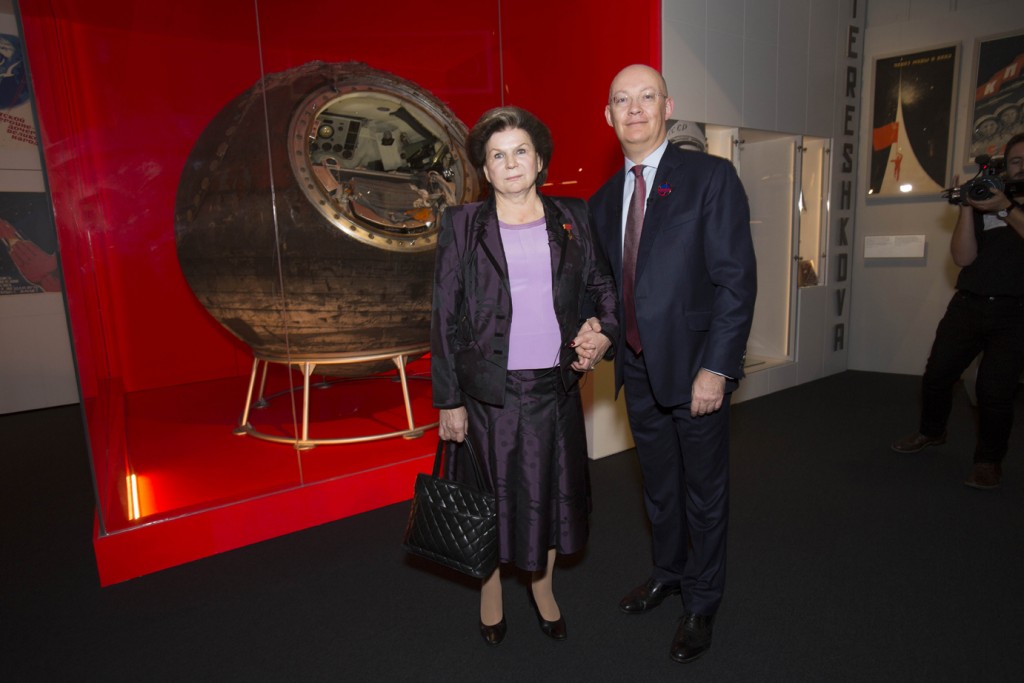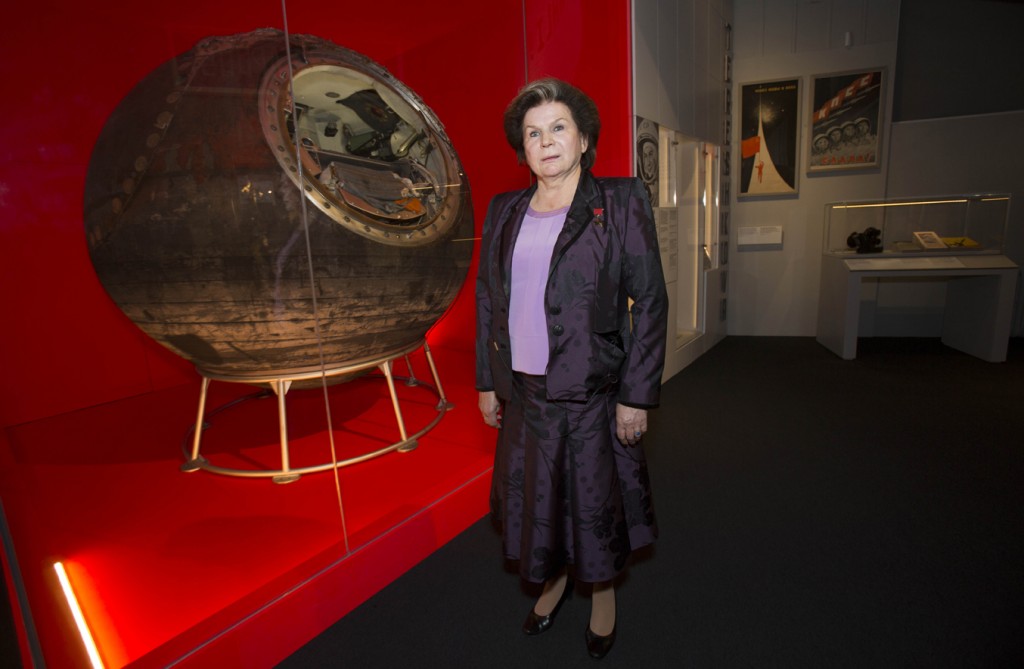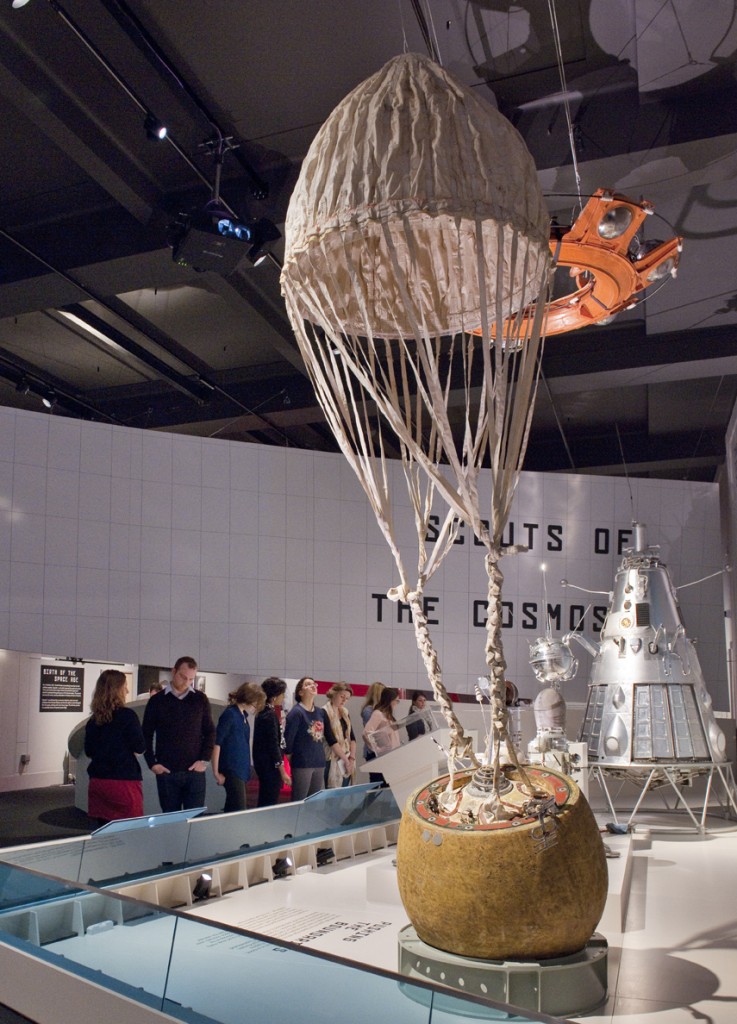Dr Valentina Tereshkova, the first woman in space, today declared that she would like to join the director of the Science Museum on a space flight during the launch of the museum’s most ambitious exhibition ever, Cosmonauts: Birth of the Space Age.

PIX.Tim Anderson
With the director, Ian Blatchford, and Dr Tereshkova was Sergei Krikalev a veteran of six space flights and eight space walks who, until very recently, held the record for the amount of time in space – 803 days, 9 hours and 39 minutes.
Mr Blatchford had joked with them that he would like to be launched into orbit explaining how, after spending five years on the project, he has great connections and ‘great moral strength – but am a physical coward.”
Tereshkova looked at him and said, in English, “together.”
To the cheers of the press pack, she explained in Russian: “If you and I went together, this would be the best proof of British-Russian cooperation.”
She said that the fact the exhibition was held in London in the Science Museum was “very symbolic of good cooperation between British and Russian scientists – of course we would like it to be broader and deeper.”
She was reunited in the museum with the spacecraft that was her home for almost three days, Vostok 6 (Russian: Orient 6) , which was launched on June 16, 1963.

PIX.Tim Anderson
That same mission made her the first civilian in space and she remains the only woman to have flown a solo space mission.
Dr Tereshkova added that every time she sees the craft, with its scorched heat-shield, she strokes it and says. “My lovely one, my best and most beautiful friend, my best and most beautiful man.”
It emerged that the Soviet scientists and engineers had forgotten a key provision when she was launched: a toothbrush. When asked how she coped, she said: “I was very resourceful, as any woman would be. I had my hands and I had water.”
But she added that, of course, this was nothing compared with a serious engineering error that made her spacecraft ascend ‘up and up’ rather than descend to Earth. “I discovered that mistake, reported it back to ground control and we corrected it.”
She implored the mastermind behind the Soviet space programme Chief Designer, Sergei Korolev, not to punish the engineer responsible. He said I want your word you would never tell anyone about it, especially journalists. I kept the secret for 30 years whereas the engineer himself told the whole world. Cosmonauts can keep their word – both men and women. Particularly women.”
Re-entry of her module was on a steep ‘ballistic trajectory,’ she explained, and it was hard to control. ‘There were huge overloads for the spaceship.”
She ended up over the Altai region of what is now the Russian Federation and “at a height of seven kilometres, I catapulted out of the spacecraft and parachuted down to Earth.”
At one point she thought she might end up in a lake. “I begged god not to land on water. God heard my prayers and allowed me to land on the shores of that lake.”
When asked if she was disappointed that there have been so few woman cosmonauts recently, she replied: “Of course I was disappointed, we were all disappointed.” But she added: “The attitude to women will change: do you hear me!”
The exhibition has several cosmonaut-flown space craft and other objects that capture the birth of the space age – and mark those extraordinary Soviet firsts that saw humans leave Earth for the first time.
Krikalev said that he was lucky to learn so much from pioneering cosmonauts such as Dr Tereshkova.

PIX.Tim Anderson
Apart from his remarkable space endurance records, he is famous for being in orbit in a space station when the Soviet Union turned into the Russian Federation. “Our operations in space were more stable than what was happening down on Earth.”
When it comes to the future of spaceflight, Krikalev said the useful life of the International Space Station will be extended to 2020, perhaps 2024.
He explained that the US and Russia are developing new spacecraft to fly beyond low Earth orbit, and Russia is considering ‘building a lunar station.”
Tereshkova added that ‘The first priority is the moon.”
Mr Blatchford said that Cosmonauts: Birth of the Space Age shows how, decades before manned flight, Konstantin Tsiolkovsky was imagining space flight and accurately predicting much of what followed. He cited Tsiolkovsky’s famous remark: “Earth is the cradle of humanity, but one cannot live in a cradle forever.”
His work inspired a whole generation. The exhibition covers milestone missions such as Luna 9, which carried out the soft landing on the Moon in 1966 (just after Korolev died), Venera 7 – first ever landing on another planet in 1970 (Venus), and the remarkable Russian expertise in long endurance missions, such as Mir.

Mr Blatchford thanked Doug Millard, space curator, who has spent almost a decade on this project, the Russian Ministry of Culture, The State Museum and Exhibition Centre (Rosizo), The Russian Space Agency (Roscomos), United Space and Rocket Corporation, British Council and the exhibition’s Lead Sponsor: BP.
On visiting the exhibition, Professor Brian Cox said: “I think you will leave the Cosmonauts exhibition with a different view of humanity’s place in the cosmos.”
Cosmonauts: Birth of the Space Age is open from 18 September 2015 – 13 March 2016. The exhibition is supported by BP and has additional support from ART RUSSE (Major Funder) and the Blavatnik Family Foundation.